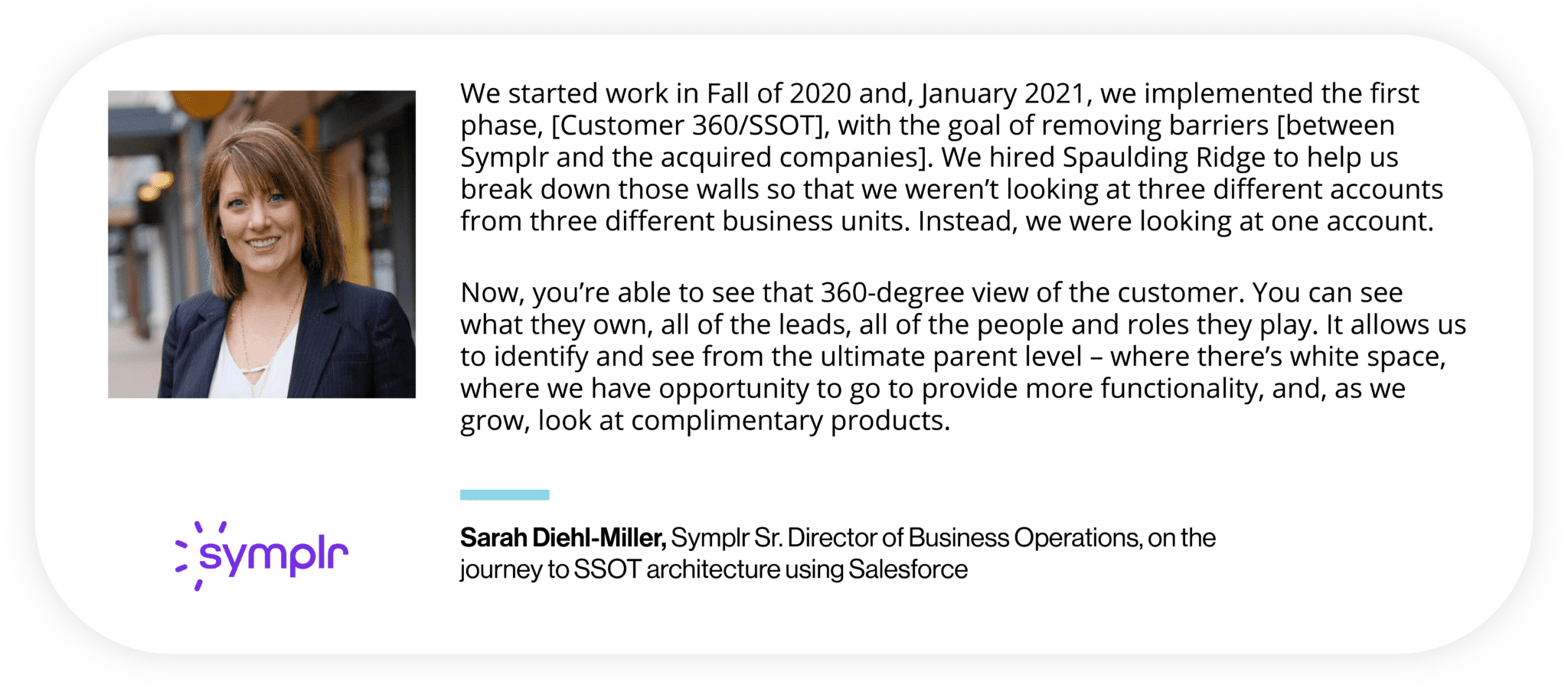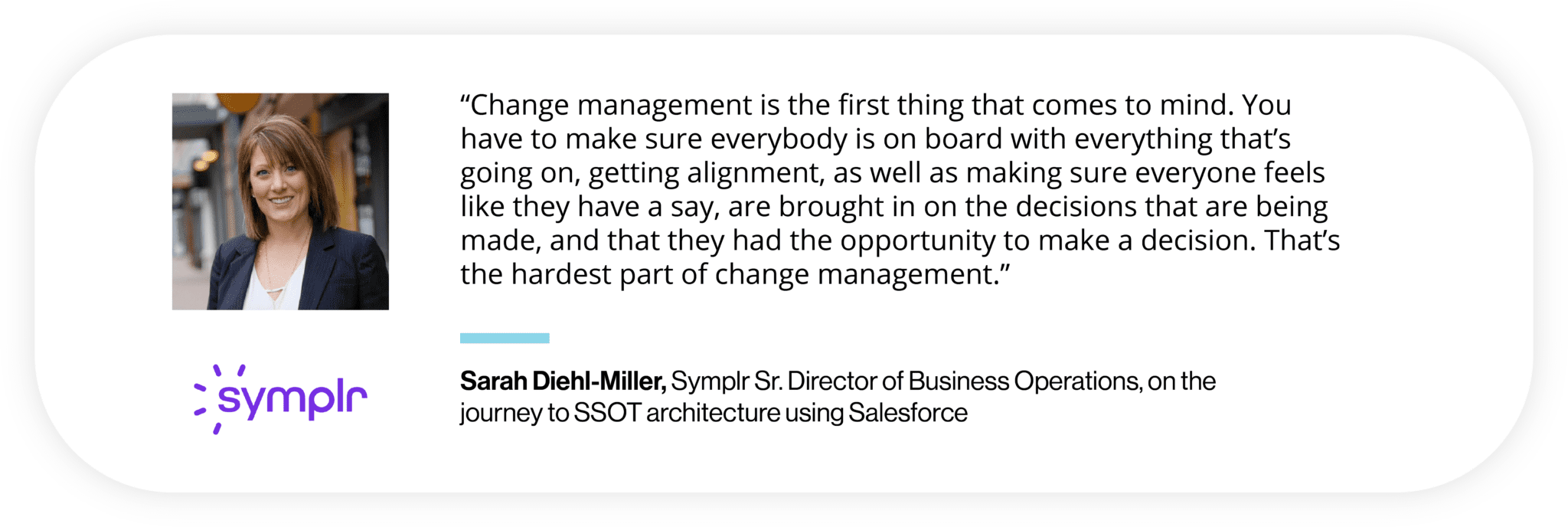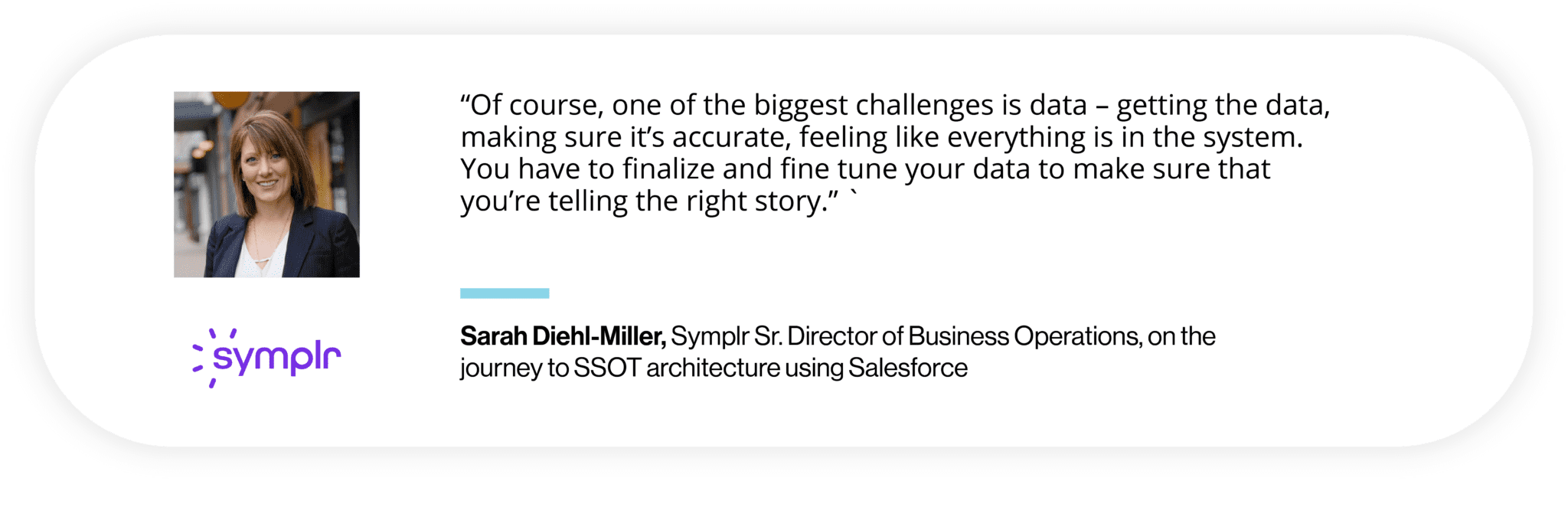- Business Transformation
- Sales & Revenue Optimization
- Finance & Operations
- Information Technology
- Private Equity
- Healthcare & Life Sciences
- High Tech
- Manufacturing
- Explore All Industries →
- Advisory + Diagnostics
- Change Management
- Implementation Services
- Cloud Application Managed Services
- Integrations
- Data Analytics
- Accelerators
- Cloud Applications
- Success Stories
- Insights + Events
- About Us
A Single Source of Truth (SSOT) makes sure that organizations are making decisions based on standardized, relevant data from across the entire company. Those decisions can range from company influencing – such as understanding your product demographic – to individual sales plays, like cross-selling products.
Most importantly, when shifting to a true data-driven company, you need to have an SSOT that provides relevant, accessible, reliable data. Not only does this enable timely decision-making, but it enhances the overall business intelligence of your organization.
What is a Single Source of Truth (SSOT)?
It seems like there should be a simple answer, but this is a deceptively difficult question, mostly because of the way we use this term.
A Single Source of Truth (SSOT) is actually an architecture – it’s the way data is treated. It’s not a system, a tool, or a strategy. It’s the practice of aggregating all business data to a single location; the key is that everyone uses the same data. If anyone from anywhere in the company is looking for this piece of data, they know this is the trusted, most up-to-date data.
There’s no “one way” to accomplish this task, therefore there are a lot of different strategies to achieve it. The one thing that most CFOs agree on is that it’s absolutely necessary. In fact, 69% of CFOs say that keeping information siloed is the biggest or most common financial mistake companies make.
In its purest form, an SSOT architecture is one where every data element is edited and managed in one place. Any other mentions of the data element in question, such as a client file, show up in other systems by reference only, so that all systems that show this client file ping the same repository for the information.
If changes are made to the client profile in the SSOT, those changes are reflected each time the client profile is pulled in all other systems.
This type of SSOT, while the “true” definition of it, isn’t feasible for most enterprises. The sheer number of departments and functions, not to mention mergers, acquisitions, and subsidiaries, make this a non-option.
More commonly, when we talk about SSOTs we’re talking about something that offers SSOT-adjacent functionality, like an SSOT for Client Information or an SSOT for Finance or, ideally, systems that seamlessly integrate and share data across all necessary platforms.
One example of the latter type would be integrating ERP and CRM, which allow Account Managers/Sales Reps to see what accounts may have delinquent invoices and could potentially churn. Functioning as an early indicator, when you combine this with customer service and support issue data, it can start to tell the larger picture of account health. Another example of this would be integrating your CLM and CRM.
An example of the former, such as an SSOT for your client information, would be using Salesforce Customer 360 Truth.
Single Source of Truth: Salesforce Customer 360 Truth
Salesforce debuted its Customer 360 in 2018. quickly followed by the Customer 360 Truth expansion in 2019. Together, they allow companies to connect, authenticate, and govern customer data and identity.
Since it uses the Cloud Information Model (CIM) which meshed with MuleSoft, Customer 360 has standardized data interoperability to integrate numerous technologies, including point-of-sale systems, contact centers, and marketing platforms.
As a result, Salesforce can unify disparate customer data and leverage personalized engagement based on a single view of clients. This can be particularly useful when undergoing mergers and acquisitions (M&A), including those with subsidiaries, such as the kind that Symplr has experienced.

Setting Your New SSOT Up For Success: Effective Change Management
To the surprise of very few, getting the tech up and running usually turns out to be the easy part.
The hard part is change management.

Improperly handled, change management can lead to an avalanche of issues, including resistance, out-of-control costs, and even employee loss. Good change management should result in employees feeling enabled and empowered, which only comes from confidence and trust in the new technology or data architecture.
Speaking of data architecture, a key component of any SSOT is well-laid out processes for data management – which is the very core of this initiative.
Single Source of Truth: Data Management
Single Source of Truth, boiled down to its core essence, is data management type. An organization can devise the best architecture for aggregating and disseminating data, but if the data isn’t pristine, it isn’t going to matter.
Gold in, gold out. Garbage in, garbage out. Gold and garbage in, gold and garbage out.
The process for inputting and managing data needs to be clearly defined, recorded, and disseminated throughout the entire company so that everyone knows how to input data and how to use the data that output.

Define Your SSOT Today with Spaulding Ridge
To make sound decisions based on accurate, real-time, reliable data, you need an SSOT.
Whether you subscribe to the “purest” of SSOT architectures or want to utilize best-in-cloud and very integrable platforms, Spaulding Ridge can advise, build entire roadmaps, and implement a customer data platform (and many more besides) to make your organization a competitive, data-driven powerhouse.
Schedule time with us today to talk SSOTs, change management, and Salesforce today.







